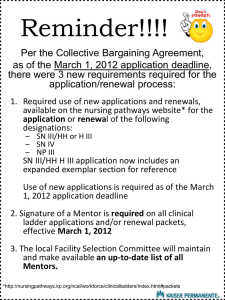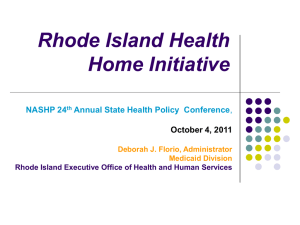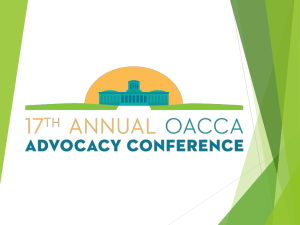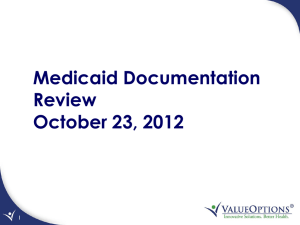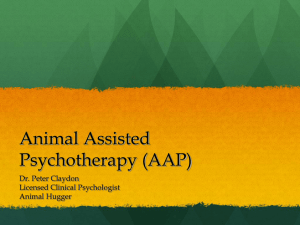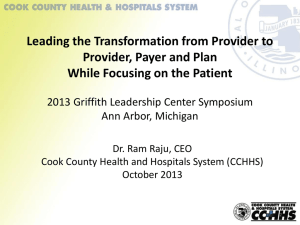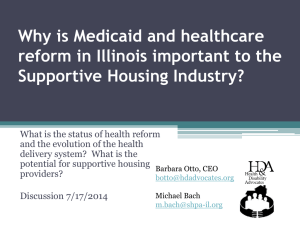Assisted Living National Update
advertisement
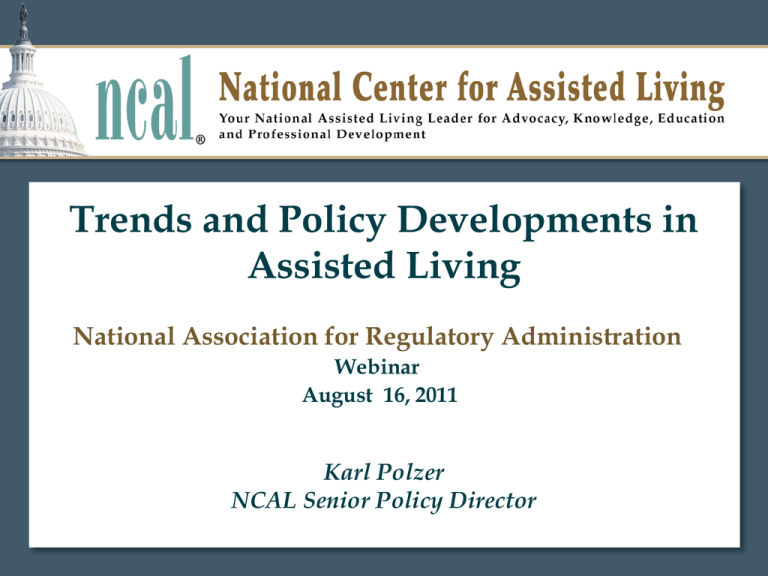
Trends and Policy Developments in Assisted Living National Association for Regulatory Administration Webinar August 16, 2011 Karl Polzer NCAL Senior Policy Director Assisted Living Residents Data from ALFA, ASHA, AAHSA, NCAL & NIC 2009 Overview of Assisted Living • Average Age = 86.9 • Average Age at Move-in = 84.6 • 73.6% Female; 26.4% Male • Average Income = $27,260 • Average Assets (including home) = $431,020 • Median Income = $18,972 • Median Assets (including home) = $205,000 Prior Residence Data from ALFA, ASHA, AAHSA, NCAL & NIC 2009 Overview of Assisted Living Private home/apartment Nursing home Retirement/IL Family residence Different ALF or group home 70% 9% 9% 7% 5% Health Conditions Data from ALFA, ASHA, AAHSA, NCAL & NIC 2009 Overview of Assisted Living Hypertension Arthritis Alzheimer’s/Dementia Coronary Heart Disease Depression Osteoporosis Macular Deg./Glaucoma Diabetes Stroke 66% 42% 38% 33% 30% 27% 19% 17% 14% ADL Dependence ALF Data from 2009 ALFA, ASHA, AAHSA, NCAL & NIC Survey • • • • • ADL Bathing Dressing Toileting Transfer Eating ALF 64% 39% 26% 19% 12% NF 96% 90% 84% 80% 53% • 81% of ALF residents need help with meds. (Average 9.9 meds daily – 7.6 prescriptions and 2.3 OTCs) Other Care Issues Data from ALFA, ASHA, AAHSA, NCAL & NIC 2009 Overview of Assisted Living • Residents need assistance with 4.5 IADLs on average with 4 out of 5 needing help with housework, laundry, medications, transportation and meal preparation • 54% use a walking device (cane, walker, etc.) and 22% use a wheelchair • 31% bladder incontinent; 14% bowel incontinent • 92% of communities arrange for /provide hospice care Residents Moving Out Data from ALFA, ASHA, AAHSA, NCAL & NIC 2009 Overview of Assisted Living Nursing home 59% Home 9% Another ALF 11% Relative’s home 5% Hospital (other than short term) 7% Independent living 4% Hospice 2% Other 4% One-third (33%) of residents die in the assisted living setting. Assisted Living Costs & Resident Income Data from ALFA, ASHA, AAHSA, NCAL & NIC 2009 Overview of Assisted Living • Average annual cost of all AL communities = $36,264 (single occupancy) • Average annual cost dementia care unit = $50,400 – Can be > $100,000 in high-cost areas. • Median resident income (all residents) = $18,972 • Median resident assets (including home) = $205,000 National Survey of Residential Care Facilities • Which federal agencies? Centers for Disease Control and Prevention’s National Center for Health Statistics. Collaborating with: • Office of the Assistant Secretary for Planning and Evaluation (HHS) • Agency for Healthcare Research and Quality (HHS) • CDC’s National Center for Chronic Disease Prevention and Health Promotion • CDC’s National Center for Immunization and Respiratory Diseases (HHS) • US Department of Veterans Affairs Why? • To collect information to help policy makers, health care planners, and providers better understand, plan for, and serve the future long term care needs of the US aging population. Data Collection • Approximately 2,250 facilities were randomly selected to participate • Information collected on: − − − − Facility characteristics (size, ownership, etc.) Resident demographics Resident health, functional status, activity involvement Resident services used and charges • Survey completed and data is being tabulated and analyzed. Final report due early 2012. National Center for Health Statistics • Reconfiguring how Feds will collect data on paid, regulated LTC providers: • • • • • Nursing Homes Home Health Care Residential Care (including assisted living) Adult Day Care Hospice • Biennial collection of ALF data that includes “policy relevant” characteristics: • • • • Provider Services Provider Staffing Provider Practices (e.g. ,transitioning or PCC) User Characteristics (e.g., % needing ADL assistance) National Center for Health Statistics • Reconfiguring how Feds will collect data on paid, regulated LTC providers: • • • • • Nursing Homes Home Health Care Residential Care (including assisted living) Adult Day Care Hospice • Biennial collection of ALF data that includes “policy relevant” characteristics: • • • • Provider Services Provider Staffing Provider Practices (e.g. ,transitioning or PCC) User Characteristics (e.g., % needing ADL assistance) Federal Policy Perspective • Battle continues over raising debt ceiling/federal spending. • Congress is cutting spending and will debate major Medicare and Medicaid cuts. • March 15 Senate Aging Committee AL Roundtable: What will be the ramifications? • Two CMS proposed rules threaten AL participation in Medicaid. • First findings from the national study of assisted living may arrive by year end. NCAL’s Policy Priorities • Keeping Regulation of Assisted Living at the State Level • Keeping Assisted Living Included in CMS’ definition of Medicaid HCB settings • Protecting, Improving Medicaid Coverage • Completing the Medicare Part D Co-Pay Fix • Helping Members Navigate the New Health Care Reform Law State Regulatory Trends • In 2010 and January 2011, at least 18 states made AL legislative/regulatory changes. • ID, KY, OR, PA, SC, & TX made extensive changes. • Focal points of change include: Life safety, Disclosure, Alzheimer’s standards, Medication Management, Background Checks, & Enforcement. • Other areas of change: move-in/move-out requirements, resident assessment, protection from exploitation, staff training, TB testing standards. Source: NCAL 2011 State Regulatory Review State Regulatory Trends • PA implemented new assisted living regulations on 1/18/2011, creating 2nd level of licensure alongside personal care homes. • In 2010, OR established rules for endorsement of care in Memory Care Communities, expanding previous Alzheimer’s care regulations. – Rules focus on person-centered care, consumer protection, staff training specific to caring for people with dementia, & enhanced physical plant & environmental requirements. • Once implemented, RI legislation will expand types of AL residents that may receive skilled nursing care or therapy, and the length of time they may receive such services. State Regulatory Trends • KY clarified that AL staff can assist with selfadministration of medications. • WA clarified that boarding homes must fully disclose to residents a facility’s policy on accepting Medicaid as a payment source. • NJ legislation requires an AL residence or comprehensive personal care home that surrenders its license and promised not discharge Medicaid residents to escrow funds to pay for care in an alternate facility. NCAL State Regulatory Review, 2011 edition available at: www.ncal.org NCAL Life Safety Initiatives • Concern among fire marshals, experts about decreased ability of AL population to evacuate without assistance is challenging current life safety standards. NCAL taking proactive steps. • National Fire Protection Association committee accepted NCAL Life Safety Code proposals for existing buildings at its June annual meeting. • NCAL also will submit proposals for new construction to International Building Code committee . • Objectives: Ensure safety; avoid shift to institutional standards, costly retrofitting; harmonize two major codes impacting AL. Federal Regulation of AL? • Trend toward AL residents with more health needs and more residents with dementia is leading states to increase AL regulation, increasing pressure for greater uniformity of state regulation. • Senate Aging Committee held assisted living “Roundtable” discussion in March. Several state AL regulators were at the table. • CMS proposed rule defining HCBS settings contains list of conditions for AL participation. Is this the beginning of federal regulation? • Many leaders in Congress are on record as supporting greater federal oversight (e.g. Henry Waxman, Pete Stark). CMS Proposed Rule Defining HCBS Settings CMS Proposed Rule “…that HCBS: must be integrated in the community; must not be located in a building that is also a publicly or privately operated facility that provides institutional treatment or custodial care; must not be located in a building on the grounds of, or immediately adjacent to, a public institution; or, must not be a housing complex designed expressly around an individual’s diagnosis or disability, as determined by the Secretary. Such qualities may include regimented meal and sleep times, limitations on visitors, lack of privacy and other attributes that limit individual’s ability to engage freely in the community.” CMS Proposed Rule The rule goes on the say: “For the purposes of this regulation, we note that ALS (assisted living settings) for persons who are older, with regard to disability, would not be excluded from home and community based setting when the following conditions are met: Individual has a lease Setting is an apartment with individual living, sleeping, bathing and cooking areas, and individuals can choose whether to share a living arrangement and with whom. Individuals have lockable access to and egress from their own apartments. Individuals are free to receive visitors and leave the setting at times and for durations of their own choosing. CMS Proposed Rule Cont.: Aging in place….must be a common practice in the ALS setting. Leases may not reserve the right to assign apartments or change apartment assignments. Access to the greater community is easily facilitated based on the individual’s needs and preferences. An individual’s compliance with their person-centered plan is not in and of itself a condition of the lease. Medicaid and Assisted Living • Rates often inadequate. • Payment for AL Incomplete (housing, food, utilities not covered; SSI check insufficient to fill gap.) • Many recent federal initiatives, regulations tend to exclude AL. • NCAL study of state Medicaid rates, payment issues released in late 2009. NCAL Medicaid Payment & Policy Study “State Reimbursement Policies and Practices in Assisted Living” Available at www.ncal.org. Study sponsored by NCAL and done by Robert Mollica, independent health policy researcher, formerly on staff of National Academy for State Health Policy. Methodology: Updates Residential Care and Assisted Living Compendium: 2007 prepared for ASPE, U.S. Dept. of HHS. Source: State web sites; Electronic survey; Telephone calls with staff responsible for HCBS programs. Data collected March – June 2009. NCAL Medicaid Payment & Policy Study Key Findings: • AL Medicaid coverage was growing again (up 9% between ’07 and ’09) after drop between ’04 and ’07 – to about 131,000 nationally at time of the study. – Medicaid covers about 13% of AL residents nationally (compared to about 63% of NH residents). • 37 states use 1915(c) HCBS waivers; 13 provide coverage directly under state Medicaid state plan; 4 include it 1115 demonstration programs; and 6 use state general revenues. States may use more than one funding source. NCAL Medicaid Payment & Policy Study • Tiered rates the most common methodology for reimbursing assisted living providers (19 states). Flat rates are used in 17 state. • 23 states cap the amount that may be charged for room and board. • 24 states supplement the beneficiary’s federal Supplemental Security Income (SSI) payment of $674, which states typically use as the basis for room and board payment. SSI combined with state supplements ranges from $722 to $1,350 a month depending on the state. Some states provide no supplement. NCAL Medicaid Payment & Policy Study • 25 states permit family members or third parties to supplement room and board charges. • 23 states require apartment style units; 40 allow units to be shared; and 24 require residents to be able to choose who they will share with. • Screening for mental health needs is performed by case managers and assisted living community staff in 9 states; by case managers only, in 10 states; and by assisted living staff only, in 9 states. • Mental health services are arranged by assisted living communities in 16 states; case managers in 20 states; and may be provided directly by assisted living communities in 3 states. NCAL Medicaid Payment & Policy Study A Few Examples of Rates for Medicaid Services: • TN rate capped at $1,100/month: or maximum of $13,200 annually (plus $674/month SSI for room and board or $8,088 annually). So maximum of $13,200 for services plus $8,088 from SSI = $21,288 annually total including room and board. • Flat rates range from about $35/day (GA)…: or $12,775 annually for services plus $8,088 SSI = $20,863 annually total including room and board. …Up to $70/day (UT): or $25,550 annually for services. NCAL Medicaid Payment & Policy Study Examples of Tiered rates: • OR has 5 payment levels ranging from $1,002 to $2,355 a month. State limits monthly room and board payment to $523.70. • OH has 3 tiers ranging from about $50/day to $70/day. Room and board is capped at $624 a month. • VT: Rates range from $36/day to $103/day plus $674 per month for room and board. NCAL Medicaid Payment & Policy Study Trends: The shift to HCB settings • Medicaid nursing facility census: 896,495 in Dec. 2008: – 8.3% less than Dec. 2001. • Number of assisted living residents receiving Medicaid LTC services: 131,000 in 2009: – 43.7% more than in 2002. • Medicaid spending for NH care is still much greater, but spending for HCB care is growing much faster: – From FY 2001–2007, Medicaid spending for HCB care rose 81.5% while spending for NH care rose 9.8%. – In FY 2007, $16.7 billion spent on HCB care v. $46.9 billion for NH care. LTC Housing Supply: Beds Per 1,000 People 65 and Older Licensed AL/RC NFs U.S. 25.7 44.1 Oregon 45.3 25.5 Nebraska 42.5 67.4 Georgia 28.1 42.6 Arkansas 12.6 61.6 Source: “State Medicaid Reimbursement Policies and Practices in Assisted Living,” Robert Mollica, National Center for Assisted Living/AHCA, September 2009. Available at www.ncal.org. HCBS as a Percentage of Medicaid Long Term Care Spending Percent HCBS U.S. 31% Oregon 57% Nebraska 22.3% Georgia 24% Alabama 13% Source: “State Medicaid Reimbursement Policies and Practices in Assisted Living,” Robert Mollica, National Center for Assisted Living/AHCA, September 2009. Available at www.ncal.org. Key questions • How will federal Medicaid rules define community settings? • Will state fiscal crisis limit AL rates? − If so, are ALFs likely to drop out? • Will AL contribute to further decline in NF use? • If Congress contemplates further stimulus of HCB care, what role will AL play? • Should federal housing subsidies be considered? New Health Care Reform Law: Provisions Impacting Assisted Living • Medicare Part D • Criminal Background Checks • Mandatory Reporting of Crimes • CLASS Act • HCB Incentives • Individual Mandates • Employer Mandates Medicare Part D co-pay fix • Medicare Part D Co-Pay Legislation (Sec. 3309 of the Affordable Care Act) − Will eliminate Part D co-pays for dual eligibles in home and community based settings covered under a Medicaid waiver – includes at least 60% of assisted living dual eligible population. − CMS has confirmed January 2012 as implementation date in final rule. • NCAL will seek a legislative fix for the remaining dual eligibles covered by state plans (the “nonwaiver” population), if necessary. Legal Changes • Criminal Background Check Funding • Reporting Crimes Occurring in Federally Funded LTC Facilities to Law Enforcement Requires reporting any reasonable suspicion of a crime resulting in “serious bodily injury” to a resident or individual receiving care, within two hours to the Secretary and at least one local law enforcement entity. Reporting required by owner, operator, employee, manager, agent or contractor of LTC facility that receives at least $10,000 in annual federal funding. Failure to report crime can result in fine up to $200,000 and exclusion from participation in federal health care programs. Impact of Coverage Expansion/Employer Mandate Provisions: Overview By 2019, PPACA estimated to reduce number of U.S. medically uninsured by 32 million through a complex combination of new mandates, fines, programs, and financial incentives. Changes being implemented in 2010 and 2011 have modest cost consequences for employers. Changes in 2014 may have significant financial impact on many LTC providers. For more information, see policy analysis and other resources on AHCA/NCAL Health Care Reform Web site: http://www.ahcancal.org/advocacy/Pages/HealthCareReform.aspx Changes in 2010 In 2010, Insurance and group health plan reforms: Prohibiting lifetime coverage limits, restrictive annual limits, coverage recissions, cost sharing for certain preventive and wellness benefits, Limiting coverage waiting periods, Requiring plans offering dependent coverage to cover young adults up to age 26. Establishing rules for “grandfathering” of plans. Waivers granted for “mini med plans” otherwise violating annual limit restrictions. Small employer tax credits. Temporary high risk pools. Temporary reinsurance subsidizing retiree health plans. Changes in 2011 In 2011, Dept. of Treasury Request for Comment on defining fulltime employees & identifying challenges employers will face in meeting new coverage requirements. HHS announces end to mini-med waivers: Applications for new waivers or extensions of current waivers must be submitted by September 22, 2011. First installment of Health Insurance Exchange rules. W-2 Reporting: employers will be required to report value of employee’s health benefits (postponed until 2012). Changes in 2014 Major changes occur in 2014: Policy “sticks”: Individuals will have to be insured, or pay fines. Employers with at least 50 full-time employees will have to meet requirements for offering health benefits, or pay fines. - including new standards for benefit levels, eligibility waiting periods, employee affordability (no more than 9.5% of family income). Employers with >200 employees offering coverage must automatically enroll employees in plan (employees can opt out). Also, employers will face new information disclosure and reporting requirements. Program Expansions, Subsidies, & Positive Impacts Policy “carrots”: Medicaid expansion: adults covered up to 133% of FPL. New health insurance “exchanges” offering individual insurance policies with federal subsidies for people with incomes between 133% and 400% of FPL. Ability for small employers to buy insurance through exchanges. Positive impacts of law include: Greater access to coverage and health care for some middleand low-wage employees, for workers in firms not offering coverage or offering plans with limited benefits, and for people outside the workforce. Greater ability to change jobs (less “job lock”). Concerns Potential Concerns for LTC Providers: Mandates could cause major labor cost increase (due to higher benefit costs, more employees taking up coverage if an employer complies with new standards – or the employer having to pay fines). Unintended consequences as employers and individuals react to complex new rules and marketplace developments. Lack of predictability/ability to plan, as the law leaves many unanswered questions. LTC Providers Most at Risk LTC providers most at risk for financial impact include: Those with high percentage of low-wage workers. Small firms not able to self-insure. Those offering limited health benefits or not offering coverage to some full-time workers. Those with low margins (e.g., NH margins have averaged about 2%-2.5% recently). Those reliant on government reimbursement (they cannot unilaterally raise prices if their labor costs suddenly go up). The Class Program Affordable Care Act establishes the new “Class” (Community Living Assistance Services and Supports) program. • “Class” will be an insurance program run by the federal government providing a cash benefit after 5 years of vesting. • Can be used to pay for assisted living. • Issues: Benefits limited; premiums may be high; lingering questions about whether program is actuarially sound. HHS pursuing changes. Medicaid Home and Community-based Services (HCBS) Expansions The ACA provides enhanced federal matching funds for Medicaid HCBS expansions in several provisions including: • The Balancing Incentive Program, which offers an FMAP increase to states that expand nursing home diversions and access to HCBS. • Money Follows the Person grant program extended to 2016. • Community First Choice Option, allowing states to offer attendant care and related supports, providing opportunities for self-direction. • Definition of home and community-based settings is a big issue for assisted living. AHRQ’s Consumer Disclosure Initiative • In July 2008, AHRQ launched the Assisted Living Disclosure Collaborative. This 18-month project resulted in a survey tool that will allow consumers to compare and select assisted living communities. • Final model tool was completed in December 2009 and was pilot tested in 2010 in Phase II. • More wide scale testing in 2011 in 8 states. • Phase III work should begin in 2011 and focus on the consumer piece of the this initiative. • NCAL continues to actively participate in this AHRQ initiative. New ALF Design Guidelines Being Drafted • Healthcare Guidelines Institute (HGI) is developing a separate set of guidelines for residential care and assisted living. • Authority for creating the guidelines was transferred from AIA to the newly created HGI. • First meetings will be in Spring 2011. • These guidelines will likely be used by state licensing agencies. • U of MN is conducting a study of existing state architectural and physical plant requirements. Federal Agencies with Initiatives Impacting Assisted Living • Centers for Medicare & Medicaid Services (CMS) Defining HCB Settings • HHS Office of Inspector General (OIG) State Oversight of Waiver Providers Examining AL Providers’ Use of Home Health • Environmental Protection Agency (EPA) Disposal of Unused Drugs Energy Use and Energy Star Programs – Energy Star for LTC buildings started March 21!!! • National Labor Relations Board (NLRB) Looking Ahead The assisted living industry has weathered the recession fairly well. Many challenges lie ahead, including: •Increasing resident acuity. •More government oversight and pressure to cut government payments. Medicaid payment cuts. Making sure AL is included in Medicaid. Changes in hospital discharge planning as Accountable Care Organizations/payment bundling take hold. Looking Ahead • Impacts of Health Care Reform • HIT / electronic health records • Workforce • Attracting and retaining qualified workers. • Training. • Making Sure that Assisted Living Stays Consumer-Driven, Focused on Providing What Residents Want and Need. National Assisted Living Week September 11 – 17, 2011 Contact Shane Osborne at sosborne@ncal.org for an electronic version of this year’s logo. The Planning Guide and Product Catalog will be available in June! Visit www.nalw.org for more information.

